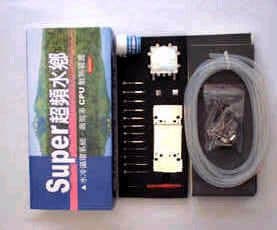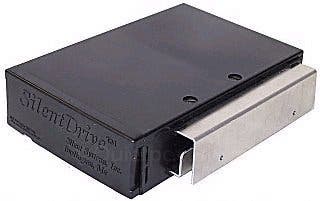The Sounds of Silence
Article - all you need to keep your PC quiet
Picture the scene. You're hiding behind a crate on de_dust, having just planted the bomb, and you can hear the sole remaining Counter Terrorist padding up to the bomb site to defuse. You crane your neck as if to hear round the crate, when whoosh! You're startled by the increased volume of your PC's many fans from this angle, and you lose your concentration, during which time your nemesis has clambered up onto the very crate you lurk behind, and emptied his M4A1 into your lap. He defuses the bomb, round over.

Something has to be done
The first step toward acoustic bliss is to work out just what is causing all the noise. The obvious culprits are the fans attached to your CPU, the one in your PC's power supply (or PSU) and the one on your graphics card. Other perpetrators include your hard disk(s) and your CD-Rom devices. Another problem may be your case rattling due to the vibrations. The first thing to do is work out what your options are. It largely depends on which bits are the loudest. It makes little sense to start at the bottom and work up, so the first thing you'll want to do is knockout the real noise-makers, usually the CPU fan and the PSU. The CPU fan is quite tricky. If you're running a very low-speed processor (usually below 400MHz) you can rely on a big purpose-built heatsink, but moving upwards you really can't get away without using a fan. One of the better bets is a radial fan from Q Technology. In the words of the manufacturers, they "employ an advanced fin design which gives a vastly superior surface area to that offered by traditional extrusion-based products." Effectively, the larger surface area means less air needs to be shifted, and so a fan with a lower RPM is used. Available from QuietPC.com.

Liquid Cooling
A more radical approach is water-cooling. Don't be alarmed; it's not about submerging your computer in liquid, merely taking advantage of the thermal properties of water. By running water continuously over the surface of the CPU, you can keep it cool and conduct the heat away. This requires a pump, a water reservoir, a water-cooling unit and a water block. The pump sends water from your reservoir along pipes to a water cooler, commonly referred to as a radiator, which chills it before piping it into the water block. The block is in direct contact with the CPU, usually made of aluminium or a similar alloy, and inside it is a zigzag of piping, through which the water travels. The piping continues out of the block and into your reservoir again, and from there the circuit continues. This approach isn't all that unsafe. You can hook up your CPU to Motherboard Monitor, which will squeal if the temperature gets out of hand, at which point you can power down and investigate what's going on. WaterCooling.co.uk is a good source of equipment, providing bundles for different purposes.

PSU
If you have cash to spend you could do a lot worse than the power supplies offered on QuietPC.com. If you can't manage this, a good tactic is to wander around computer fairs (Tottenham Court Road's fairs in London are a safe bet) and ask to hear some of their PSUs in operation. Some very quiet units can be found - one unit we heard from Seventeam was virtually silent. At the very low end, you can get away with a fanless PSU. We don't recommend modifying your own, as if certain components burn out you can end up shoving a lot of power into your hard disk, CPU and motherboard. Not a good idea. However, some purpose-built fanless PSUs are available. TKPower, although somewhat difficult to deal with, offer a fanless <150W unit, which will suffice for lower end PCs. Monstrous Athlons can consume nearly 65W on their own, which is unfeasibly large for a 150W PSU. Check out the power consumption levels in your computer's BIOS (hit Del at startup) to find out what you're using. Some users have reported success installing their own fans into leading PSUs. Again, we cannot possibly recommend this, but it is possible. At the moment, purpose-built quiet PSUs are the best bet, and QuietPC has a monopoly on them. With prices to match.

The Rest
Keeping your drives quiet isn't all that difficult. Make sure they aren't rattling the case by putting washers on the screws and tightening them appropriately, or if your PC is relatively stationary, you might like to embed them in some foam padding in a 5.25" drive bay. 7200RPM performance drives are usually quite loud, but you can counter this by setting power saving to spin them down whenever they aren't in use. The only problem here is that whenever you access the root of your storage array (e.g. My Computer), Windows spins them up for a Label reading. An unfortunate problem and unlikely to be resolved, regrettably. Beware of "SilentDrive" enclosures too. These may subdue a lot of the noise your drives make, but it also cooks them quite quickly. If your drive doesn't give off much in the way of heat, it may be viable, but do watch it. CD-Rom devices generally aren't a problem. Take the usual steps to muffle them by employing washers and tightened screws, and otherwise, just don't rely on them too heavily.
Conclusion
If you follow our advice and perform some of the measures listed here on your own PC, you may discover it a more worthy expenditure of a few pounds than say, a new keyboard you've been thinking of buying for a while. Having a quiet PC is a godsend, and something that should be a reality for everyone. Personally, this writer can't wait for AMD's forthcoming range of "Palomino" processors, which will allegedly require so little power to operate that a fan will not be necessary.








